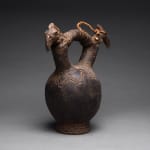Grasslands Terracotta Vessel with Two Spouts and Bird-Headed Stoppers, 20th Century CE
Terracotta
25.4 x 25.4 cm
10 x 10 in
10 x 10 in
MT.304 (LSO)
This impressive two-spouted ceramic vessel appears to have been made by one of the numerous Grasslands groups of Cameroon, specifically the Bamileke or Bamun people. It is essentially a cimple...
This impressive two-spouted ceramic vessel appears to have been made by one of the numerous Grasslands groups of Cameroon, specifically the Bamileke or Bamun people. It is essentially a cimple globular form, with an incised decoration pedestal base and a rounded top. The ground is undecorated, except for a series of incised chevrons around the shoulders – from whence the paired spouts emerge – and a row of beading that connects the aforementioned bands through the space made by the spouts. These are plain, and connected superiorly by an arched handle which is clad in raffia. The spouts are stopped by bird’s heads, which are attached to the handle by lengths of raffia twine.
The Grasslands contains numerous small, quasi- independent kingdoms, notably the Bamileke, the Bamenda-Tikar and the Bamum. The king/fon/leader of the group and his courtly associates are equipped with regalia and prestige objects, leading to a proliferation of craftsmen and artists who occupied valuable social roles within the community. Even secular objects are decorated with characteristically Grasslands iconography, although function cannot always be ascertained, as in the current case.
Given the peculiar nature of its construction it is likely to have occupied a supra-secular function, perhaps for administering libations or sharing valuable liquids such as wine. Whatever its purpose, it is an attractive and impressive piece of African art.
The Grasslands contains numerous small, quasi- independent kingdoms, notably the Bamileke, the Bamenda-Tikar and the Bamum. The king/fon/leader of the group and his courtly associates are equipped with regalia and prestige objects, leading to a proliferation of craftsmen and artists who occupied valuable social roles within the community. Even secular objects are decorated with characteristically Grasslands iconography, although function cannot always be ascertained, as in the current case.
Given the peculiar nature of its construction it is likely to have occupied a supra-secular function, perhaps for administering libations or sharing valuable liquids such as wine. Whatever its purpose, it is an attractive and impressive piece of African art.



